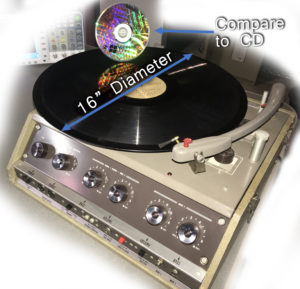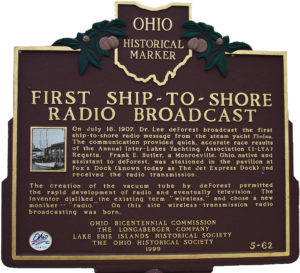What are Transcription Records?
 Transcription phonograph records were used exclusively by the radio industry before the advent of the superior magnetic audio tape technology. They were 16” in diameter making them much larger than those used for the consumer market. The large size facilitated playing times up to 15 minutes per side. This enabled pre-recordings of entire radio shows including commercials. An illustration is shown at right comparing the familiar compact disk (CD) to a 16” transcription record. Because of the large size transcription records cannot be played on consumer grade record players. A special transcription player (as shown in the illustration) must be used.
Transcription phonograph records were used exclusively by the radio industry before the advent of the superior magnetic audio tape technology. They were 16” in diameter making them much larger than those used for the consumer market. The large size facilitated playing times up to 15 minutes per side. This enabled pre-recordings of entire radio shows including commercials. An illustration is shown at right comparing the familiar compact disk (CD) to a 16” transcription record. Because of the large size transcription records cannot be played on consumer grade record players. A special transcription player (as shown in the illustration) must be used.
The Driving Force Behind Transcription Records
Few people realize that while commercial radio dates back to 1922, magnetic audio recording only became a reality in the early 1940s. Everybody knows that a successful radio station absolutely must have a means to pre-record programs for regular playback. So what were commercial radio stations supposed to use for those roughly two decades? A capability to play pre-recordings to the masses was critical if commercial radio was to be a viable industry.
Although the phonograph had already been invented in the nineteenth century, prior to 1920 most music that was heard (whether in public or private homes) were live productions. We know this is true because sheet music consistently outsold records of the same hit songs. A hit song’s sheet music often sold in the millions between 1910 and 1920. During that time recorded versions of hit songs were valued mainly for their ability to promote the sheet music.
Jazz was invented in 1917 and Blues music began appearing in records starting in 1921. This was a great driving force in bringing phonograph recordings and phonographs to the consumer industry.
An Industry Waiting for Phonograph Recordings
 Until about 1920 radio was only used for communication such as ship-to-shore. In 1920 a new company, RCA, was created by General Electric. RCA was to explore and root out the commercial potential of radio. Commercial radio stations were created and radio receivers began appearing in more and more residential homes. In 1924 radios typically cost in excess of $200 but only three years later they typically sold for well under $50.
Until about 1920 radio was only used for communication such as ship-to-shore. In 1920 a new company, RCA, was created by General Electric. RCA was to explore and root out the commercial potential of radio. Commercial radio stations were created and radio receivers began appearing in more and more residential homes. In 1924 radios typically cost in excess of $200 but only three years later they typically sold for well under $50.
In 1920 phonograph technology had a long way to go. Even though the radio technology of that day was primitive by our standards, live music productions sounded much better on the radio than phonograph recordings. It didn’t help much that Herbert Hoover as Secretary of Commerce (before he became President in 1929) prohibited the playing of records on air. But technology improved with electrification replacing hand-crank technology. Phonograph technology eventually became good enough that on air use was acceptable. The term “transcription” was born. Radio programs could be “transcribed” for on air production. Today we would call these recordings.
Radio Had Special Needs
To be truly cost-effective radio had to be able to transcribe productions for playback. It was a huge advantage to be able to transcribe an entire 30 minute show, including sponsored content, for playback at a later date. These recordings could also be sent to other sister radio stations for playback there as well. In some cases international law prevented telephone line use for radio program distribution between stations. Transcription solved this problem.
But There Was A Problem
Although phonograph recording technology in 1924 was acceptable for on air music production, there was a time limitation. Recordings were cut at 78 rpm and record diameters were 12”. This only allowed for five-minute recordings—two per record, front and back. Whole radio shows need to be 30 minute recordings.
In 1928 a new electrical transcription technology was introduced. The recording speed was 33 1/3 rpm and vinyl disks of 16” diameters were used. This enabled 15 minutes of material per side for a total of 30 minutes. This technology was so much improved that it was considered impossible to distinguish the difference from live and transcribed programs.
